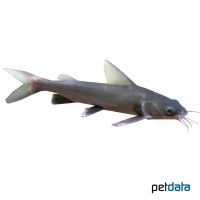Colombian Shark Catfish (Ariopsis seemanni)
| Colombian Shark Catfish Ariopsis seemanni | |
|---|---|
| Name | Colombian Shark Catfish |
| Name Lat. | Ariopsis seemanni |
| Synonym | Arius jordani |
| Family | Sea Catfishes |
| Family lat. | Ariidae |
| Order | Catfishes |
| Order lat. | Siluriformes |
| Origin | America |
| Habitat | Estuaries, lagoons |
| Diet | Carnivore |
| pH | 6.8-8.5 |
| Behavior | Peaceful |
| Keeping | Group |
| Care Level | Moderate |
| Reproduction | Mouthbrooder |
| Breeding | None reported |
| Life Span | 10-15 years |
| Protection | No |
| Metric Units | |
| Size | 30-35 cm |
| Temperature | 22-26 °C |
| Hardness | 10-30 °dH |
| Aquarium | ~ 500 l |
| US Units | |
| Size | 12"-14" |
| Temperature | 72-79 °F |
| Hardness | 178-534 ppm |
| Aquarium | ~ 130 gal |
Distribution and habitat
Silver shark cross catfish are widely distributed along the Pacific coast from Mexico through Central America to Peru. They live in the brackish water of estuaries. Juveniles are often found in freshwater, while older animals are found in brackish and seawater.
Maintenance
The aquarium should have numerous hiding places, such as stone caves (e.g. perforated rock) and mangrove roots, as well as plenty of free swimming space. A dark, round-grained substrate of sand, low lighting and a medium current is ideal
No ammonia, ammonium or nitrite should be detectable, and the nitrate value should not exceed 100 mg/l. To ensure the water quality and oxygen content, a filter and heater adapted to the aquarium size is required, as well as lighting for the species-appropriate day-night rhythm of the animals.
Diet
The food supply consists of strong live food, such as artemia, mysis and mosquito larvae, which are also eaten frozen without problems, supplemented according to the size of the fish with mussels, shrimp and fish pieces or a commercially available frozen food mixture. After acclimation, sinking dry food for catfish, such as pellets, granules and tablet food, is usually also accepted
A regular and varied diet promotes health and prevents deficiency symptoms. Only as much should be fed as is eaten immediately (in a maximum of 10 minutes).
Behaviour and compatibility
These peaceful and compatible fish should be kept in a group of 3-5. They can be well socialized with larger, active fish in a brackish water aquarium. Fish that are too small are considered food.
Generally, only compatible fish species with similar water condition and water temperature requirements should be socialized.
Sex dimorphism
No external distinguishing characteristics are known. Adult females appear rounder than the males.
Reproduction and breeding
They are paternal mouth brooders. The male carries the fertilized eggs upstream in his mouth where they are deposited in freshwater. After hatching, the fry remain in freshwater for some time before returning to brackish water
There are no known reports of successful breeding in the aquarium.
Important
The permanent keeping of Ariopsis seemanni is only possible in brackish water. Juvenile fish can be kept in fresh water, where an addition of sea salt of 1-2 tablespoons per 10 l of water is recommended. As the fish age, the salinity must be increased (10-30 ‰ salinity)
Great care should be taken when catching or handling them in the aquarium, as they have a venom gland at the base of the first dorsal spine. A sting injury can result in a very painful swelling.
They are capable of making clearly audible sounds with their pectoral fins. It is believed that these sounds are used for communication or orientation (echolocation).
The well-being of the fish should be checked regularly. The temperature should be checked daily, the pH, hardness and nitrate value at least every 14 days. Regular partial water changes are recommended, even if the pollutant load has not yet reached the upper limit. Sudden changes in water quality should be avoided. Newly introduced fish must be accustomed slowly to the water in the aquarium.
Further literature can be found in your pet store.
References
Text: Werner Winter; Image: petdata
Source: BMELV (1998): Tierschutzgutachten - Haltung von Zierfischen (Süßwasser); BAENSCH & RIEHL (2004): Aquarien Atlas Bd. 2, Mergus Verlag; ENGELMANN (2005): Zootierhaltung - Tiere in menschlicher Obhut: Fische, Verlag Harri Deutsch
- Gemäß § 21 Abs. 5 Tierschutzgesetz idgF
